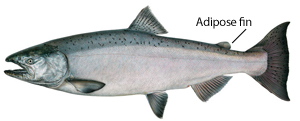|
May 17, 2016
Contact: Phil Schneeberger, 906-249-1611, ext. 311 or Elyse Walter, 517-284-5839
Chinook salmon fishery in Lake Superior dominated by wild fish
The Department of Natural Resources reports that Michigan’s Lake Superior Chinook salmon fishery is being fueled almost entirely from natural reproduction. Data show more than 99 percent of the Lake Superior Chinook salmon caught by anglers are wild.
 All 1.5 million Chinook salmon stocked in Lake Superior since 2012 have received adipose fin clips via the U.S. Fish and Wildlife Service’s mass marking program, making it easy to distinguish which fish are either wild or of hatchery origin. The percentage of fish that are wild is derived from the ratio of unclipped versus clipped Chinook salmon examined by DNR creel clerks. These percentages have been very high for three years running, lending increased confidence to the finding. All 1.5 million Chinook salmon stocked in Lake Superior since 2012 have received adipose fin clips via the U.S. Fish and Wildlife Service’s mass marking program, making it easy to distinguish which fish are either wild or of hatchery origin. The percentage of fish that are wild is derived from the ratio of unclipped versus clipped Chinook salmon examined by DNR creel clerks. These percentages have been very high for three years running, lending increased confidence to the finding.
An average of around 3,000 Chinook salmon are caught yearly by sport anglers in Lake Superior. This ranks this species as the third highest to be sustained by natural reproduction in this water body, following lake trout and coho salmon.
“Having such consistent catches coming from wild fish is something to celebrate,” said Phil Schneeberger, the DNR’s Lake Superior Basin coordinator.
Assessments like this are important when evaluating stocking effectiveness and provide information needed to make proper management decisions about where to put fish and how to spend angler license dollars most wisely. The DNR will continue to monitor Chinook salmon catch data to help ensure the long-term viability of this important species in the Lake Superior fishery.
For more information on marked and tagged fish in Michigan, visit Michigan.gov/taggedfish.
The Michigan Department of Natural Resources is committed to the conservation, protection, management, use and enjoyment of the state’s natural and cultural resources for current and future generations. For more information, go to www.michigan.gov/dnr.
|

 All 1.5 million Chinook salmon stocked in Lake Superior since 2012 have received adipose fin clips via the U.S. Fish and Wildlife Service’s mass marking program, making it easy to distinguish which fish are either wild or of hatchery origin. The percentage of fish that are wild is derived from the ratio of unclipped versus clipped Chinook salmon examined by DNR creel clerks. These percentages have been very high for three years running, lending increased confidence to the finding.
All 1.5 million Chinook salmon stocked in Lake Superior since 2012 have received adipose fin clips via the U.S. Fish and Wildlife Service’s mass marking program, making it easy to distinguish which fish are either wild or of hatchery origin. The percentage of fish that are wild is derived from the ratio of unclipped versus clipped Chinook salmon examined by DNR creel clerks. These percentages have been very high for three years running, lending increased confidence to the finding.




